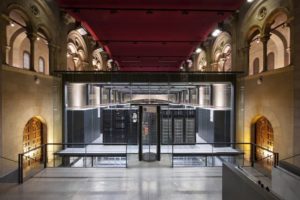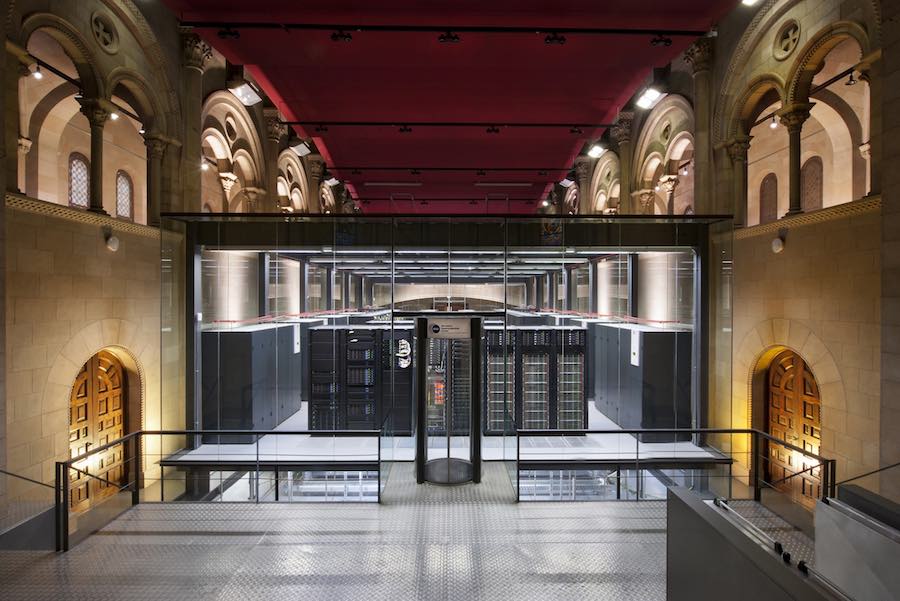 Today the Barcelona Supercomputing Center announced plans to MareNostrum 4, a 13.7 Petaflop supercomputer that will be 12.4 times more powerful than the current MareNostrum 3 system. In a contract valued at almost €30 million, IBM will integrate in one sole machine using its own technologies alongside those of Lenovo, Intel, and Fujitsu.
Today the Barcelona Supercomputing Center announced plans to MareNostrum 4, a 13.7 Petaflop supercomputer that will be 12.4 times more powerful than the current MareNostrum 3 system. In a contract valued at almost €30 million, IBM will integrate in one sole machine using its own technologies alongside those of Lenovo, Intel, and Fujitsu.
With this purchase, BSC-CNS has pursued a dual objective: to acquire a general-purpose machine capable of executing all types of scientific and engineering tasks, and to provide itself with clusters built with emerging technologies. These clusters will serve users’ needs and, in turn, will allow the centre to test and analyze the performance of the most recent developments in the field of supercomputing.
To this end, the new machine will have two distinct parts. The general purpose element, provided by Lenovo, will have 48 racks with more than 3,400 nodes with next generation Intel Xeon processors and a central memory of 390 Terabytes. Its peak power will be over 11 Petaflops, which is to say that it will be able to perform more than 11,000 trillion operations per second, ten times more than the MareNostrum3, which was installed between 2012 and 2013. Despite this increase in capacity, it will consume only 30% more power, reaching 1.3 MW/year.
The second element of MareNostrum 4 will be formed of clusters of three different technologies that will be added and updated as they become available. These are technologies currently being developed in the US and Japan to accelerate the arrival of the new generation of pre-exascale supercomputers.
One of these clusters will consist of IBM POWER9 processors and NVIDIA GPUs, which are the same components that IBM and NVIDIA will use for the Summit and Sierra supercomputers that the US Department of Energy has commissioned for the Oak Ridge and Lawrence Livermore National Laboratories. Its computing power will be over 1.5 Petaflops.
The second cluster will be made up of Intel Knights Landing (KNL) and Intel Knights Hill (KNH) processors provided by Fujitsu and Lenovo respectively. They are the same processors that will be inside the Theta and Aurora supercomputers purchased by the US Department of Energy for the Argonne National Laboratory. Its computing power will be in excess of 0.5 Petaflops.
Finally, a third cluster will be formed of 64 bit ARMv8 processors that Fujitsu will provide in a prototype machine, using state-of-the-art technologies from the Japanese Post-K supercomputer. This cluster’s computing power will also be over 0.5 Petaflops.
The goal of the progressive incorporation of these emerging technologies into MareNostrum4 is to enable BSC to operate with what are expected to be some of the most state-of-the-art developments of the coming years and to test if they are suitable for future versions of MareNostrum.
Disc Storage
MareNostrum4 will have a disk storage capacity exceeding 10 Petabytes and will be connected to the Big Data infrastructures of BSC-CNS, which have a total capacity of 24.6 Petabytes. Like its predecessors, MareNostrum4 will also be connected to the network of European research centres and universities through the RedIris and Geant networks.
PRACE and the Spanish Supercomputing Network
The path towards the upgrade of the MareNostrum supercomputer began with a decision taken by the Spanish Council of Ministers at its meetings of 4 and 18 December 2015. The decision authorized the budget adjustments necessary for the Ministry of Economy and Competitiveness to contribute €34 million plus VAT to BSC for the purchase of MareNostrum 4. €30 million of this sum has been allocated for the purchase of MareNostrum 4’s calculation clusters and for work on the electrical and cooling systems necessary for the computer to function correctly. The remaining €4 million has been used for MareNostrum 4’s parallel disc system.
Like its predecessor MareNostrum 3, the new supercomputer will be part of the Partnership for Advanced Computing in Europe (PRACE), a network which has the objective of creating a European high performance computing infrastructure.
The arrival of MareNostrum 4 will allow for a new phase of the PRACE European supercomputing project in which Spain will be able to maintain its status of core member alongside Germany, France, Italy and Switzerland, the latter having recently joined the network.
MareNostrum 4 will also be part of the Spanish ICTS network of unique scientific and technological infrastructures in Spain and of the Spanish Supercomputing Network (RES). The new supercomputer will increase RES’s calculation capacity and will replace MareNostrum 3, the components of which will be distributed among various nodes of the network.
Brief history of MareNostrum
MareNostrum is the generic name used by BSC for the various versions of its most emblematic supercomputer. The MareNostrum machines have served over three thousand scientific and technical research projects since the first version was installed in 2004. At the time, MareNostrum had a calculation capacity of 42.35 Teraflop/s (42.35 trillion operations per second). In 2006, it was upgraded and doubled its capacity to 94.21 Teraflop/s. Since the last upgrade (2012-2013), MareNostrum 3 has had a peak performance of 1.1 Petaflops (eleven hundred trillion operations per second).
MareNostrum is a facility at the service of the scientific community and of society. Supercomputers are now one of the fundamental pillars of science and engineering. Without them, it would be impossible to carry out a significant amount of research and a substantial number of the projects which require a large capacity for calculation and data handling. They are used to create models and simulations, and to manage vast quantities of information generated by studies in all scientific areas.




